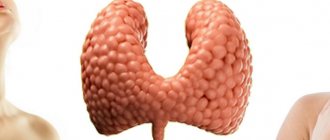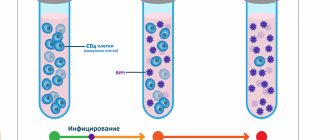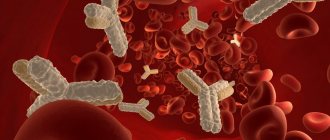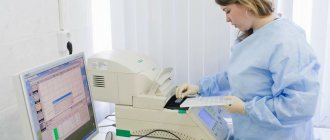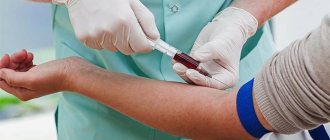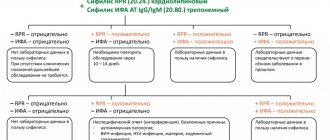Hepatitis C is asymptomatic in the vast majority of cases. For a long time, only mild malaise and increased fatigue may indicate the presence of infection. If the presence of a virus in the body is suspected, a diagnostic complex is prescribed, including general examinations and a blood test for hepatitis C. A similar diagnosis is carried out before prescribing antiviral therapy.
Antibodies to hepatitis C virus (total)
Antibodies to the hepatitis C virus are normally absent in the serum. Total antibodies to the hepatitis C virus are antibodies of the IgM and IgG classes directed to the complex of structural and non-structural proteins of the hepatitis C virus. This study is a screening test to identify patients with VSH.
Total antibodies to the hepatitis C virus can be detected in the first 2 weeks of the disease, and their presence indicates possible infection with the virus or a previous infection. It is impossible to obtain an unambiguous answer based on the results of this test, since the test determines total IgM and IgG antibodies. If this is an early period of acute viral hepatitis C, then this is indicated by IgM antibodies, and if this is a period of convalescence or a condition after suffering from HCV, then this is indicated by IgG antibodies.
IgG antibodies to HCV can persist in the blood of convalescents for 8-10 years with a gradual decrease in their concentration. Late detection of antibodies is possible a year or more after infection. In chronic hepatitis C, total antibodies are constantly determined. Therefore, to clarify the timing of infection, it is necessary to separately determine IgM antibodies to HCV.
Evaluation of the study results
The result of the study is expressed qualitatively - positive or negative. A negative test result indicates the absence of total antibodies (JgM and JgG) to HCV in the blood serum. A positive result - the detection of total antibodies (JgM and JgG) to HCV indicates the initial stage of acute viral hepatitis C, the acute period of infection, the early stage of convalescence, previous viral hepatitis C or chronic viral hepatitis C.
However, the detection of total antibodies to HCV is not sufficient to make a diagnosis of HCV and requires confirmation to exclude a false-positive test result. Therefore, when a positive result of a screening test for total antibodies to HCV is obtained, a confirmatory test is performed in the laboratory. The final result of determining total antibodies to HCV is issued together with the result of the confirmatory test.
Preparation and delivery of blood tests for hepatitis C
The composition of the blood depends on many factors: the person’s condition; time of day; meals, etc. That is why preparation is necessary to obtain a reliable interpretation of a blood test for hepatitis C. Before donating blood, it is recommended:
- 2-3 days in advance, eliminate the consumption of alcohol, as well as fatty and fried foods;
- It is recommended to avoid stress and excessive physical activity during the day;
- You should refrain from eating any food for 8 hours before being tested for hepatitis C.
Experts also recommend stopping taking any medications. If this is not possible, your doctor should be notified.
Patients whose tests for hepatitis C have confirmed the presence of the disease should not despair. Modern medicine has means to combat the virus - drugs based on sofosbuvir, daclatasvir, velpatasvir and ledipasvir. The medicines have passed all the necessary stages of research and confirmed the effectiveness of antiviral therapy.
Antibodies to hepatitis C virus JgM
Antibodies to the hepatitis C virus JgM are normally absent in the serum. The presence of JgM class antibodies to HCV in the patient’s blood makes it possible to verify active infection. Antibodies of the JgM class can be detected not only in acute HCV, but also in chronic hepatitis C.
Antibodies of the JgM class to HCV appear in the patient’s blood 2 weeks after the development of the clinical picture of acute viral hepatitis C or exacerbation of chronic hepatitis and usually disappear after 4-6 months. A decrease in their level may indicate the effectiveness of drug therapy.
Biochemical blood test for hepatitis C
This type of diagnostics is among the most informative specialists. Based on the results of the analysis for hepatitis C, it is possible to determine the degree of organ damage and assess the general condition of the patient. The most important indicators in this laboratory test are bilirubin, AST and ALT.
Bilirubin
Normally, the amount of bilirubin in the blood should not exceed 19.8 µmol/l. An increase in pigment concentration indicates an activation of the process of erythrocyte breakdown and the presence of liver pathologies in the patient. Jaundice syndrome occurs when bilirubin levels increase above 30 µmol/l. The result of an analysis for hepatitis C with indicators from 30 to 86 µmol/l is confirmation of mild, 87-160 µmol/l - moderate, over 160 µmol/l - severe form of hyperbilirubinemia.
ALT and AST
They are enzymes produced by the liver. With HCV, their level rapidly increases and the enzymes reach the affected organ. The normal levels of AST and ALT are different for men and women. The AST level in women should be no more than 30 IU/l; in men, the test result for hepatitis C normally reaches 45 IU/l. For AST indicators, the norm is set within 30 and 47 IU/l, respectively.
Protein
The concentration of protein in the blood is affected by the process of synthesis and breakdown of two main fractions. The norm is the protein content in the blood in the range of 66-83 g/l. If, when reading tests for hepatitis C, a decrease in the indicator is detected, the presence of hepatitis or cirrhosis can be suspected.
Additional Research
Additionally, the de Ritis coefficient can be calculated, which is the ratio between ASI and ALT. In addition, changes in creatinine content, as well as an increase in triglyceride content, may indicate the development of pathologies. At the same time, do not forget that exceeding the norm of fat may indicate diabetes mellitus or obesity. The result of a test for hepatitis C based on a creatinine content of 39.9-72 µmol/l is normal. For triglycerides, the indicator is set at 3.62 µmol/l.
Detection of hepatitis C virus by PCR (qualitative)
The hepatitis C virus is normally absent in the blood. Unlike serological methods for diagnosing HCV, where antibodies to HCV are detected, PCR allows you to directly detect the presence of HCV RNA in the blood, both qualitatively and quantitatively. The detectable fragment in both is a conserved region of the hepatitis C genome.
The detection of only antibodies to HCV confirms only the fact of infection of the patient, but does not allow one to judge the activity of the infectious process (virus replication) or the prognosis of the disease. In addition, antibodies to the HS virus are found both in the blood of patients with acute and chronic hepatitis, and in those patients who were sick and recovered, and often antibodies in the blood appear only several months after the onset of the clinical picture of the disease, which makes diagnosis difficult. Detection of the virus in the blood using PCR is a more informative diagnostic method.
Qualitative detection of HCV by PCR in the blood indicates viremia, allows us to judge the reproduction of the virus in the body and is one of the criteria for the effectiveness of antiviral therapy.
The analytical sensitivity of the PCR method is at least 50-100 viral particles in 5 μl of DNA sample isolation; specificity is 98%. Detection of hepatitis C virus RNA using PCR in the early stages of the development of a viral infection (possibly as early as 1-2 weeks after infection) against the background of the complete absence of any serological markers can serve as the earliest evidence of infection.
However, isolated detection of hepatitis C virus RNA in the absence of any other serological markers cannot completely exclude a false-positive PCR result. In such cases, a comprehensive evaluation of clinical, biochemical and morphological studies and repeated repeated confirmation of the presence of infection by PCR is required.
According to WHO recommendations, to confirm the diagnosis of viral hepatitis C, triple detection of hepatitis C virus RNA in the patient’s blood is necessary.
- Detection of hepatitis C virus RNA by PCR is used for the following purposes:
- resolution of questionable results of serological studies;
- differentiation of hepatitis C from other forms of hepatitis;
- identification of the acute stage of the disease in comparison with previous infection or exposure; determining the stage of infection of newborns from mothers seropositive for the hepatitis C virus;
- monitoring the effectiveness of antiviral treatment.
Polymerase chain reaction (PCR)
The next step after anti-HCV IgM and IgG is a polymerase chain reaction test. With its help, it is possible to detect the RNA of the virus in human blood, determine the degree of load and the genotype of the disease. There are several types of PCR tests for hepatitis C.
- Qualitative testing is used to identify the genetic material of the virus in a patient's blood. The test result for hepatitis C is indicated as “detected” or “not detected”. In the second case, the indicator may be false negative. This occurs in cases where too little time has passed since infection and the number of pathogens has not reached the level determined during testing.
- Quantitative analysis allows you to determine the concentration of the virus. This indicator plays a key role in developing a treatment regimen for HCV. The decoding of the hepatitis C PCR analysis is issued in a digital value: less than <1.5x10*3 IU/ml - the concentration has not reached the lower threshold; <4x10*6 IU/ml – a small amount indicating the onset of the disease; >4x10*6 IU/ml – high amount; >2x10*8 IU/ml – concentration above the linear limit.
In addition to qualitative and quantitative analysis for hepatitis C, genotyping of the disease is carried out. Knowing the genotype, it is possible to accurately predict the response of the virus to treatment with a particular drug and develop an optimal treatment regimen.
Detection of hepatitis C virus by PCR (quantitative)
A quantitative method for determining the content of hepatitis C virus RNA in the blood provides important information about the intensity of the disease, the effectiveness of treatment, and the development of resistance to antiviral drugs. The analytical sensitivity of the method is from 5.102 copies/ml of viral particles in blood serum, specificity is 98%.
The level of viremia is assessed as follows: when the HCV RNA content is from 10^2 to 10^4 copies/ml – low; from 10^5 to 10^7 copies/ml – medium and above 10^8 copies/ml – high.
Quantitative determination of HCV RNA in blood serum by PCR is important for predicting the effectiveness of interferon-alpha treatment. It has been shown that individuals with a low level of viremia have the most favorable prognosis of the disease and the greatest likelihood of a positive response to antiviral therapy. With effective treatment, the level of viremia decreases.
Complexes with this research
Preparation for IVF for a man Examination to prepare a man for the IVF procedure 6,210 ₽ Composition
Hospital complex Infectious screening for prevention and hospitalization 2,140 ₽ Composition
Preparation for partner childbirth for a man Tests necessary to accompany a woman in labor RUB 3,750 Composition
IN OTHER COMPLEXES
- Future dad 8,650 RUR
- Examination during pregnancy. 3rd trimester 9,840 RUR
- Joining IVF RUB 23,500
- Examination during pregnancy. 1st trimester 17,040 RUR
- Male infertility. Extended examination RUB 29,360
Hepatitis C: what a patient needs to know
Hepatitis C is one of the most insidious and deadly viruses. In 90% of cases, they are asymptomatic. Due to its ability to disguise the true cause under the guise of many other diseases, it was nicknamed the “gentle killer.” If the disease does make itself felt, its active phase is divided into two main periods: pre-icteric and icteric. In the first (early) period, symptoms characteristic of viral infections are observed, such as:
- general weakness;
- skin itching;
- digestive disorders: nausea, vomiting, diarrhea;
- increase in body temperature up to 38°C;
- headaches, myalgia, arthralgia.
In the second (icteric) period, when the liver is affected, a large amount of bilirubin, a yellow pigment, is released into the blood. It is thanks to the icteric staining of the patient’s skin that it becomes obvious that he has obvious problems with the liver, and a set of laboratory tests of blood, urine and feces is prescribed.
However, many cases of infection are asymptomatic, without a characteristic clinical picture. After an incubation period, which lasts from a couple of weeks to a couple of months, the patient may not even suspect that he is a carrier of the virus not only in the prodromal (pre-icteric) stage, but also in the icteric stage - due to its absence as such. For example, in 2/3 of all cases, hepatitis C occurs in an atypical (anicteric, or subclinical) form.
Patient preparation rules
venous blood
Standard preparation conditions (unless otherwise determined by the doctor):
4 hours before, withstand fasting, exclude fatty foods.
You can drink water. capillary blood Standard preparation conditions (unless otherwise determined by the doctor):
4 hours before, withstand fasting, exclude fatty foods. You can drink water.
You can add this study to your cart on this page

